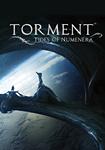
Torment: Tides of Numenera - Interview @ RPS
Rock, Paper, Shotgun has posted the second part of their interview for Torment: Tides of Numenera. As usual here is a short sample of the interview.
RPS: Have you come up against any design dilemmas where you decided to do something that – from the outside looking in – would appear to be in direct opposition to Planescape’s design? What other factors do you take into account in these situations? Beyond the obvious surface-level, “Well, PST did it this way or that way” stuff?
Heine: In most cases, we’re just taking what PST did and pushing it further. The Tides are a prime example of that. PST pretty much broke the rules of D&D’s alignment system to achieve its goals. Now that we’re not tied to any system, we thought, “What were those goals, and what’s an alignment system that could accomplish them even better?” The result is a more organic and nuanced system than what PST had.
When we do break from what PST did, we have to ask ourselves why PST did it that way, what they were trying to accomplish, and is our proposed solution better than that? For example, early on I had assumed that combat would be allowed anywhere – because that’s how PST did it, and because I, being a relatively old-school gamer, had never played a game where you couldn’t do that. Others had assumed the opposite.
The ensuing discussion forced us to ask important questions. Did PST allow combat anywhere because it was the right thing to do or because that’s how the Infinity Engine worked by default? Was it a critical part of PST? This is a tricky question, because for any given aspect, there will always be some people who believe that it was. Did it work and was it a good decision for PST?
We determined somewhat reluctantly that it wasn’t critical to PST and that it added a lot of work for the designers and scripters at the time. Then we had to decide: is our proposed solution better? What does it gain us? What do we lose by it? In removing the possibility of combat anywhere. We lost some perceived freedom, but we gained more focus on our core vision – no trash mobs, quality, handcrafted encounters that support the narrative, etc, and a heck of a lot of time that would otherwise be spent designing, implementing, and debugging reactivity to handle the case where any combination of NPCs might have died. Because that time would be spent improving quality and reactivity elsewhere in the game, where it would be more likely to be seen by more players, we decided to drop the “kill anyone” approach.
But then as dialogues and designs started coming in, we realized it was almost too restricting. I mean, sure, we don’t have to cater to the player who just wants to slaughter everyone to see what happens, but if an NPC is in your way and really pissing you off, shouldn’t you have the option to smack them down? The problem with this is that our Crisis concept demands a limited number of handcrafted situations, but we couldn’t go through the whole game handcrafting every possible scenario where the player might want to get into a brawl.
The solution was what we called mini-Crises, or Tussles. They’re basically shorter, non-handcrafted combats that are always entered into by player choice or occasionally by player failure, but usually the player will be aware that he’s trying something that could start a fight. In this way, we can give the player freedom to attack people that are reasonable to attack, while still maintaining control over which NPCs can die and when. It also gives players who want to focus on combat more opportunities to do what they’re good at.
Though, as with everything, we still need to prove out how well these will work, or how much extra effort will be necessary for them to work well, before we can commit to it. If Tussles as we currently imagine them prove too ambitious, we have some fallback ideas that would allow for this type of freedom in other, simpler ways.
Information about
Torment:ToNSP/MP: Single-player
Setting: Technofantasy
Genre: RPG
Platform: PC
Release: Released

